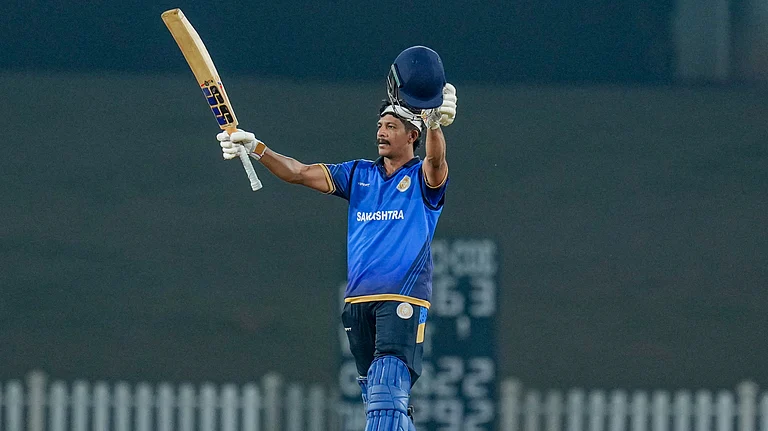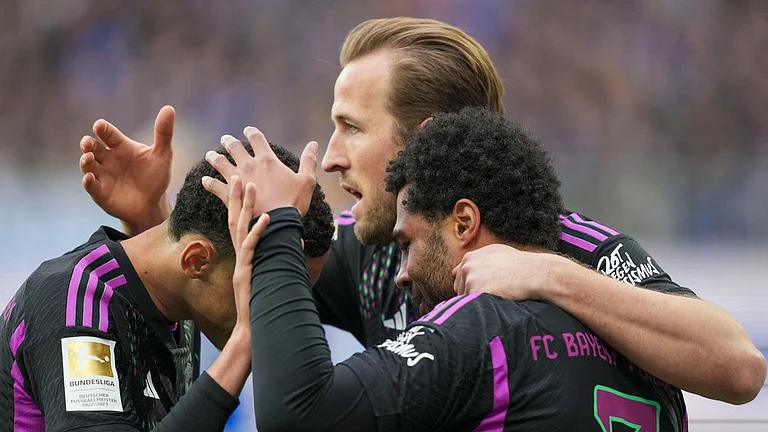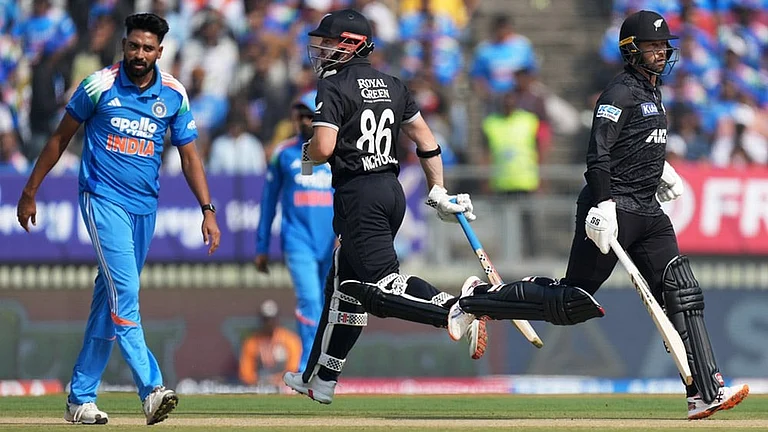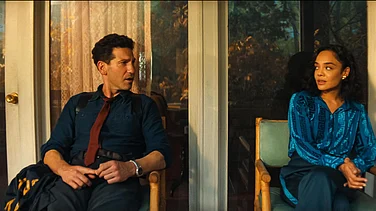"He is our god,” the man says, looking reverentially at the 80-ft-high cutout, supported by a scaffolding that rises to the skies outside the theatre. Superstar Rajinikanth smiles rakishly from the cutout designed in vibrant hues to match a still from the film. The ritual prayer—offered to the cutout of their hero, nay, god, before the first show begins—is just over. Strewn across are remnants of the paraphernalia—garlands, thalis with camphor, sweets and pots of milk. The fans now climb a ladder placed against the cutout to bathe it with pots of milk, adorn it with flowers, light the camphor to the chime of bells. They climb down the ladder and distribute sweets that had earlier been offered as prasad to the cutout, among fans who had been thronging the proscenium arch since 3 am. They believe this pre-release ritual would ward off the evil eye and assure the film’s box office success. In the land that birthed the atheist Dravidian self-respect movement and gave the slogan “Tamizh engal moochu (Tamil is our breath)”—it is scarcely believable that the people’s hero is a Marathi-speaking Kannadiga with demigod status.
The Southern states love their silver screen stars. The love for cinema started even before the country got its freedom. Nothing seemed odd that the stars’ popularity was well within the confines of their linguistic borders. Language tied the audience in an emotional bond, brought solace to the drab, unexciting life of the man on the street.
Rajini is not the South’s only matinee idol. From Kollywood’s regal N.T. Rama Rao in his empyrean roles, MGR—the darling of the masses, and the fan’s thalapathi Vijay; to the dashing Chiranjeevi and Nagarjuna of Tollywood; Sandalwood’s saintly Rajkumar lighting up screens with soulfully lip-synched songs, to Mollywood’s women audiences swooning over Mammootty’s dialogue delivery—across Tamil, Telugu, Kannada and Malayalam screens—they are a dime a dozen.
But none was ever deified like Rajini.
Dravida Nadu—geographically, the ice-cream cone south of the Vindhyas—is a strange land. Especially Tamil Nadu, which bore witness to the self-respect movement in the first half of the last century—a unique campaign in these climes that had rejected divinity and the Brahminical hierarchy as a symbol of caste oppression. The Dravidian movement’s total rejection of all forms of religion resulted in an impoverished iconography. Inevitably, it led to other, more eclectic forms of worship—resurrection of subaltern gods Karumariamman and Adhiparashakthi for the believers, larger-than-life matinee idols and politicians for the atheists.
Your gods could be leaders of the two warring political parties—DMK and AIADMK—but how do you shower reverence to your leaders who are beyond your reach? That’s where the cutouts enter the public domain and begin to dominate the skyline—leaders projected as giants—a placeholder for the gods that were destroyed. What propelled this development was the social churn that ran parallel to it—the growth of cinema as mass entertainment, and the cross-fertilisation between the silver screen and the political realm. Cinema was no longer mere entertainment, but a potent medium of political propaganda. With theatre artists, scriptwriters, dramatists and actors propelling the Dravidian movement’s ‘social reform’ agenda, it was a cinch that the leading lights started segueing seamlessly from one field to another. Behind the unprecedented success of Tamil cinema was the ingenuity of activists of the Dravidian movement, who defined the zeitgeist like nowhere else in the country, or perhaps the world.
Rajinikanth’s debut on the Tamil screen was momentous. The age of MGR and Sivaji Ganesan was on the wane. It was as if the audiences in their 20s were in search of a hero they could connect with. With his swarthy, rugged looks and uncouth demeanour, he instantly resonated with the marginalised, socially deprived Tamil youth recently empowered by the Dravidian movement. His on-screen persona belonged to the downtrodden. He smoked, drank and mouthed obscenities in rustic Tamil. His irreverent mannerisms hummed with the mood of the masses itching to defy authority, and his stylish tricks captivated the wretched of the earth—the dark-skinned, lower caste, school dropout filled with self-doubt, could identify with him as one of their own. He redeemed their irrelevance through his larger-than-life fight sequences, and gave them hope of deliverance.
From the shadows and sounds in the dark theatre, rose the man who became immortal. For the fans, his dialogues metamorphosed from written script to gospel truth that carried a promise of a better future. Fan clubs sprang up organically across the barrios before trade analysts could finish counting the box office returns. Long before Bitcoin was invented, Rajnikanth’s name defied conventional analysis to become an ephemeral currency in Tamil filmdom. Fans built castles and hoped their king would one day ascend its throne to protect them. Even before he formally entered politics, his shadow had cast a benign envelope over the volatile world of Dravida politics. Luckily for tinsel town, the bewildered star decided to withdraw from the murky world soon after his entry into politics.
Strangely enough, the Kannadiga never quite managed to capture the Kannada audience that was hooked to the likes of Rajkumar, representing conventional themes. Perhaps the idea of defying authority wouldn’t have gone down well with Kannada producers. Perhaps, the lack of an accompanying social revolution like in Tamil Nadu played its part.
But now comes a whiff of change on the Kannada screen. With the stupendous success of KGF 2, the hitherto-unheard-of Yash—an articulate, earthy, confident star-in-the-making—is poised to emerge as a larger-than-life superstar, the kind that has been Telugu and Tamil cinema’s metier. Perhaps, his emergence signifies societal changes we were unaware of.
So are the success stories of larger-than-life stars in recent Telugu hits that have overshadowed Tamil and Hindi cinemas in their own backyards. Even Rajnikanth’s stars seem to be on the wane, with his last few releases turning into damp squibs. Maybe his fans are jaded with all his over-the-top action sequences, chest thumping dialogues and empty slogans.
Bollywood—forever the bearer of Hindi chauvinism as a nationalist project, could never begin to understand regional aspirations—and never quite managed to enter the demigod game.
Back in Tamil Nadu, the mood has changed after the pandemic. The audience now seems to want wholesome entertainment. No longer do they seem to crave those titanic characters playing gods on screen. And without the ringing of the turnstiles, the star’s fame and adulation begins to take little time to wane. No one understands that better than those demigods of the silver screen. The success of a film still remains a mystery, because, thank god, the stars are not gods.
(This appeared in the print edition as "Kolossus of the Roads")
(Views expressed are personal)
Vaasanthi is a journalist who has written several books on superstars of tamil cinema & politics





















